The New Parish Church of St Laurence
An extensive refurbishment and rebuilding of churches was taking place during the mid-1800s, against a background of poorly maintained buildings, a reaction against the continuing rise of non-conformism, and a perceived shortage of churches in the growing urban areas. The Cambridge Camden Society and the Oxford Movement were at the forefront of a drive towards a more medieval attitude to churchgoing, and the change was embraced by the Church of England which saw it as a means of reversing the decline in attendance. The Cambridge Camden Society advocated a return to a ‘correct’ form of building based on churches which had been built during the hundred years centred on 1300. If a church could not be ‘restored’ to this original state, then it was a candidate for a complete rebuild. The Oxford Movement advocated moving the centre of importance in the church from preaching to the sacrament of the Eucharist; from the pulpit to the altar. Consequences of this included moving the pulpit from a more central position to the side of the church, replacing box pews with open pews, creating a central aisle to give a better view of the altar, the removal of galleries, and a larger chancel. A total of 3,765 new and rebuilt churches were consecrated in the 40 years up to 1875, with the most active decade being the 1860s, in which there were more than 1,000 such consecrations. Over 7,000 parish churches in England and Wales (nearly 80% of the total) were restored in some way between 1840 and 1875. Stroud was not immune from these developments, and in 1866, under the incumbency of Rev John Badcock, the whole of the existing parish church, with the exception of the original 14th century tower and spire, was pulled down and rebuilt.

1866 Demolition and laying the Foundation stone
An article in the Stroud News & Journal newspaper in 1977 (13 January) gives some insight into the concerns at the time of the Victorian demolition and rebuilding:
"The rebuilding of Stroud Parish Church, which was completed in 1869, was, perhaps, the most formidable task carried out by Wall and Hook. Ten years before, the vicar, the Rev. T. H. Tarlton, had found that on Mondays “he generally felt as if all the vitality had gone out of him, owing to the imperfect ventilation but it was the conditions in the chancel which caused him most dismay. “It was his duty” the Stroud Journal reported, “to sit in the chancel if he was not reading prayers, but he never sat there without having an abhorrence of the place. He was sitting below the soil that contained the dead, under the drainage of the churchyard........there was a great amount of damp and effluvia from the graves all round the eastern end”. There were also complaints of impurities arising from the vaults, immediately under the noses of the congregation and that in the vaults under the chancel coffins were floating. The north wall was bulging ominously and the roof needed attention. One of the galleries was unsafe. The seating came in for strong criticism. One third of the congregation had to sit with their backs to the minister, there were those who could get no farther than the porch and the poorer members were packed together, inhaling each other's breath, jammed knee to knee. One of the principal critics was Dr. W. H. Paine, a church warden, who said “I would give liberally to support the parish church for parish purposes, but I shall not put my hand in my pocket to find coals and gas and comforts for those who are the landlords and owners of the pews”. In the protracted dispute as to whether or not to proceed with the restoration , at one stage Dr. Paine referred to the “beautiful” church at Bisley, which had recently been restored (by Wall and Hook) where the service was conducted in a decent and orderly manner and proper accommodation provided for all the parishioners, even the poorest - “and this, too, in the little town of Bisley, which we have been almost accustomed to despise. Then we look at our church in Stroud – dirty, ill-ventilated, inconvenient, and delapidated, we can hardly help feeling ashamed of it”. The same, alas, could not be said of Bisley Church today; for some years now the walls of the nave have looked very shabby, while Stroud has maintained in sound condition the good work carried out by Wall and Hook. Much of the stonework was the responsibility of Joshua Wall, the sculptor, who was soon to die on December 21st. 1869 at the age of 34. An exhibitor at the Royal Academy in his time, his last work was for the Grand Pump Room Hotel, Bath."
Article kindly supplied by Alexander Hook


1868 Consecration
The new church was consecrated and re-opened for worship by the Bishop of Gloucester and Bristol, Bishop Dr Charles J Ellicott, in August 1868. A celebration dinner for the aged poor was also held in the Subscription Rooms.




Consecration Poem (1868)
Our Parish Church is now Re-built, And may it prove to be
A Building Consecrated to, the blessed One-in-Three;
May the Almighty Triune God Breathe on it from above,
And fill His Priests with heavenly light, His Saints with holy love
May Organist and Choristers The Holy Ghost inspire,
And e'en the Organ's solemn sound be fill'd with holy fire.
May many a Soul have cause to bless This Consecration Day,
And from it date the happy hour they first began to pray.
Before that Altar, richly spread With Elements Divine,
May many a sinner feel God's love around his heart entwine.
The various Stars in Chancel Roof Will tell us, that above,
Tho' each with different glory shine, 'twill be no bar to love.
O may those Crowns bright emblems prove To all who bend the knee,
May each one have a crown to wear throughout eternity.
May Angels guard the sacred Font, And every Infant be
Regenerated through the Blood once shed on Calvary.
May every Monumental Scroll A solemn thought inspire,
And those pure Robes by angels worn become our one desire.
May every Painted Window help Our feelings to refine,
And to the contemplative prove an inexhaustless mine.
May every Sabbath Chime possess A more melodious sound,
And holy, happy, heavenly smiles, on every face be found.
And last, (not least), may every Gift Upon the Altar laid,
Be given with a cheerful heart-in heaven 'twill be re-paid.
W.H.B. BAILY, TYP.


West Wall Monuments
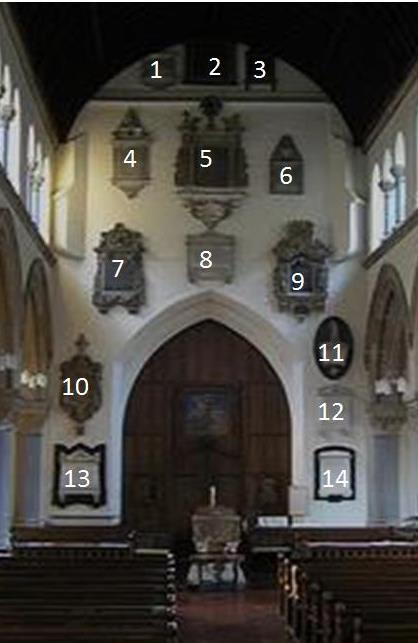
- DURLEY WINTLE, from Harpton Court, Radnorshire, died 1792.
- Extension of east end of old church in 1787, at the joint expense of JOHN ALLWAY, NAT PEACH, WILLIAM CAPEL, THOMAS BAYLIS, BENJAMIN GRAZEBROOK, HENRY BURGH, EDWARD THORNTON, WILLIAM ELLIS, Clerk and Minister.
- DEBORAH WEBB, spinster, died 1759
- EDWARD FIELD of Field Place, Justice of the Peace, died 1736; monument erected by ANNE, his widow and second wife, daughter of RICHARD PLUMMER
- JOHN GRYFFIN and ELIZABETH his wife, interred 1627; ELIZABETH, his granddaughter, wife of JOHN WEBBE of the Throp, clothier, buried 1681; ELIZABETH, daughter of JOHN GRYFFIN, wife of THOMAS CLISSOLD, clothier, buried 1703; JOHN GRYFFIN, died 1719; THOMAS GRYFFIN, Magistrate, died 1728
- Revd WILLIAM ELLIS, died 1804
- RICHARD COLE, died 1739; WILLIAM PHELPS, died 1735;
- SAMUEL SNOWDEN MD, died 1822; MARY, his wife, died 1845 (buried at North Petherton, Somerset); JOHN SNOWDEN, their only son, died 1856 (at North Petherton, and buried in the family vault)
- RICHARD FIELD of Fields Place, died 1693; ELIZABETH his wife, daughter of EDWARD HILL of Cam, died 1715; JOANNA FIELD; EDVARDI [EDWARD] FIELD; JOHANNIS [JOHN] DELABERI of Southam, died 1730
- DANIEL CAPEL AM [son], died 1709; DANIEL CAPEL [father], died 1714
- ELIZABETH Wife of JOHN KNOWLES, died 1790 (buried in Bisley); WILLIAM KNOWLES, son of JOHN and SARAH KNOWLES of Paradise House, Painswick, died 1801; JOHN KNOWLES of Paradise House, Painswick, died 1809
- BENJAMIN FISHER, died 1825; MARGARET, his wife, died 1823; HENRY, their son; their other children– BENJAMIN (died 1833) buried at Fairford, ELIZABETH (died 1838), WILLIAM (died 1845), JOSHUA (died 1845), JOHN (died 1848), CHARLES (died 1849), SAMUEL (died 1861); PRISCILLA WYATT, widow, died 1865; JOSEPH TIMBRELL FISHER, died 1869; PAUL HAWKINS FISHER, died 1873 (Find out more about Paul Hawkins Fisher under Social History)
- WILLIAM STANTON of the Thrupp, died 1841; ANN, his wife, died 1842
- SOPHIA, wife of Revd MATHEW BLAGDEN HALE, Perpetual Curate of the Parish, died 1845; LOUISA, their eldest child, died 1843.
1878 A Remarkable Exhibition of Strong Nerves and Coolness.
Restoration of the spire was required after a major lightning strike in March 1878. The event was photographed and published as a postcard with the caption, “While this photograph was being taken, W. Cheriton, a member of the choir, stood on the highest point of the spire balancing on one leg – a remarkable exhibition of strong nerves and coolness.”

1883 Heating the Church
John Grundy (1807- 1879) was a grocer and flour dealer who lived in Tyldesley, near Manchester. He was a churchwarden at his local church, and was most concerned at the discomfort he felt during the winter. So he set about resolving the problem by erecting a central heating apparatus by using a stove, flues, chimney and ventilators. John Grundy Ltd was subsequently established in 1857, and he continued to improve his heating apparatus, increasing its efficiency and effectiveness, and additional Patents. By the 1870s the firm had become a successful business, and his son, John Grundy Junior (1844-1913) (photo top left), decided that the firm should be based in London. The Grundy warm air stove heating apparatus proved a great success and was installed in several cathedrals, and numerous churches and chapels throughout the country.

1894 The Parish Magazine
The first issue of the Stroud Parish Church Magazine, January 1894




Late 19th & Early 20th Century Developments
The new church was endowed with a fine series of Victorian stained glass windows at its rebuild between 1866 and 1868, which were gradually added to in the period up to 1922. Makers include Heaton, Butler & Bayne, Lavers & Barraud, H Hughes, Ward & Hughes, and JCN Bewsey. For More information about the church windows, please click HERE
The fine reredos was designed by George Gilbert Scott Junior in 1872, and was carved by Morris Geflowski, with high relief panels of Gethsemane, the Crucifixion and Deposition by Edward Geflowski. It was coloured and gilded in 1970 in memory of Charles Aldridge and Henry Philpotts.
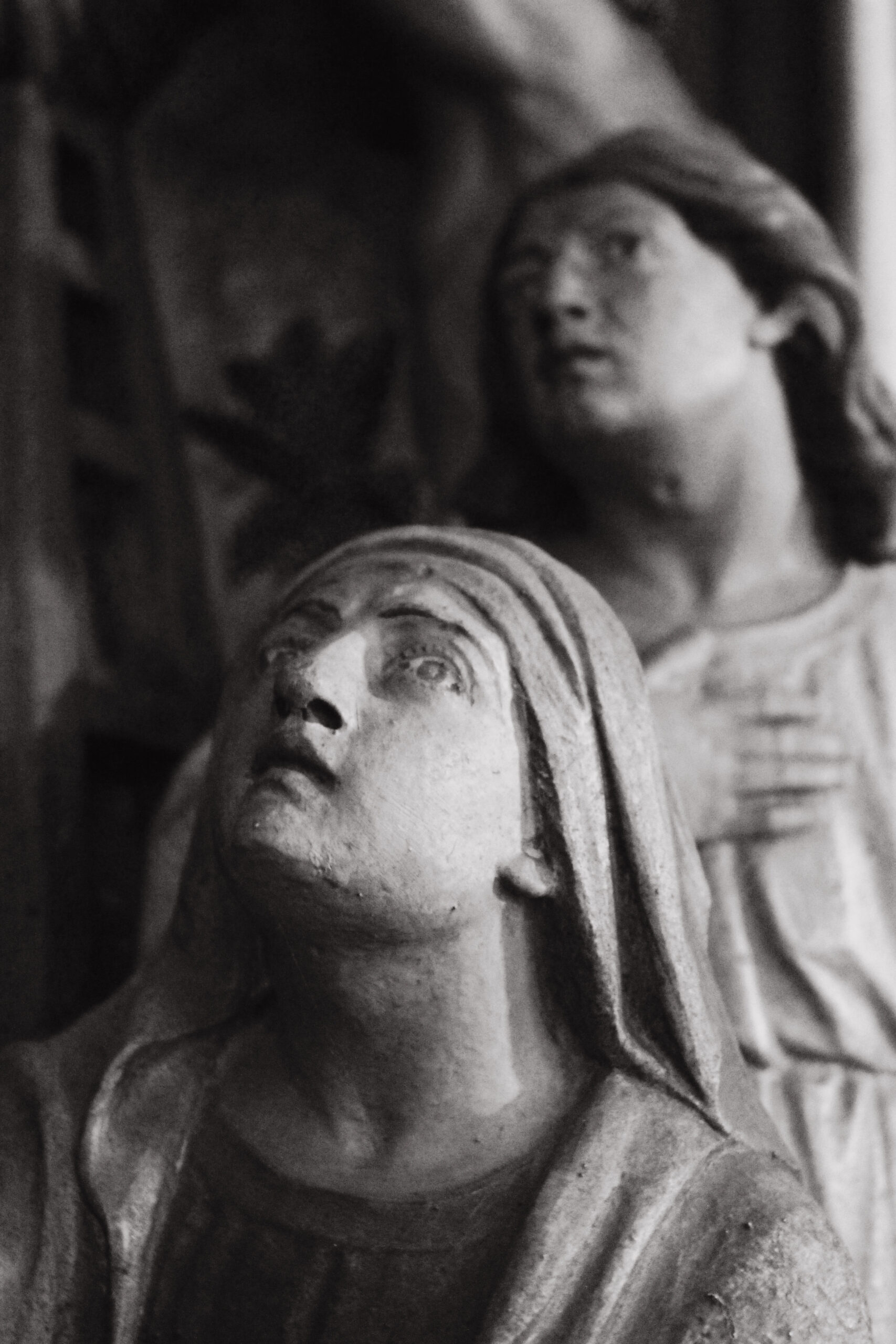
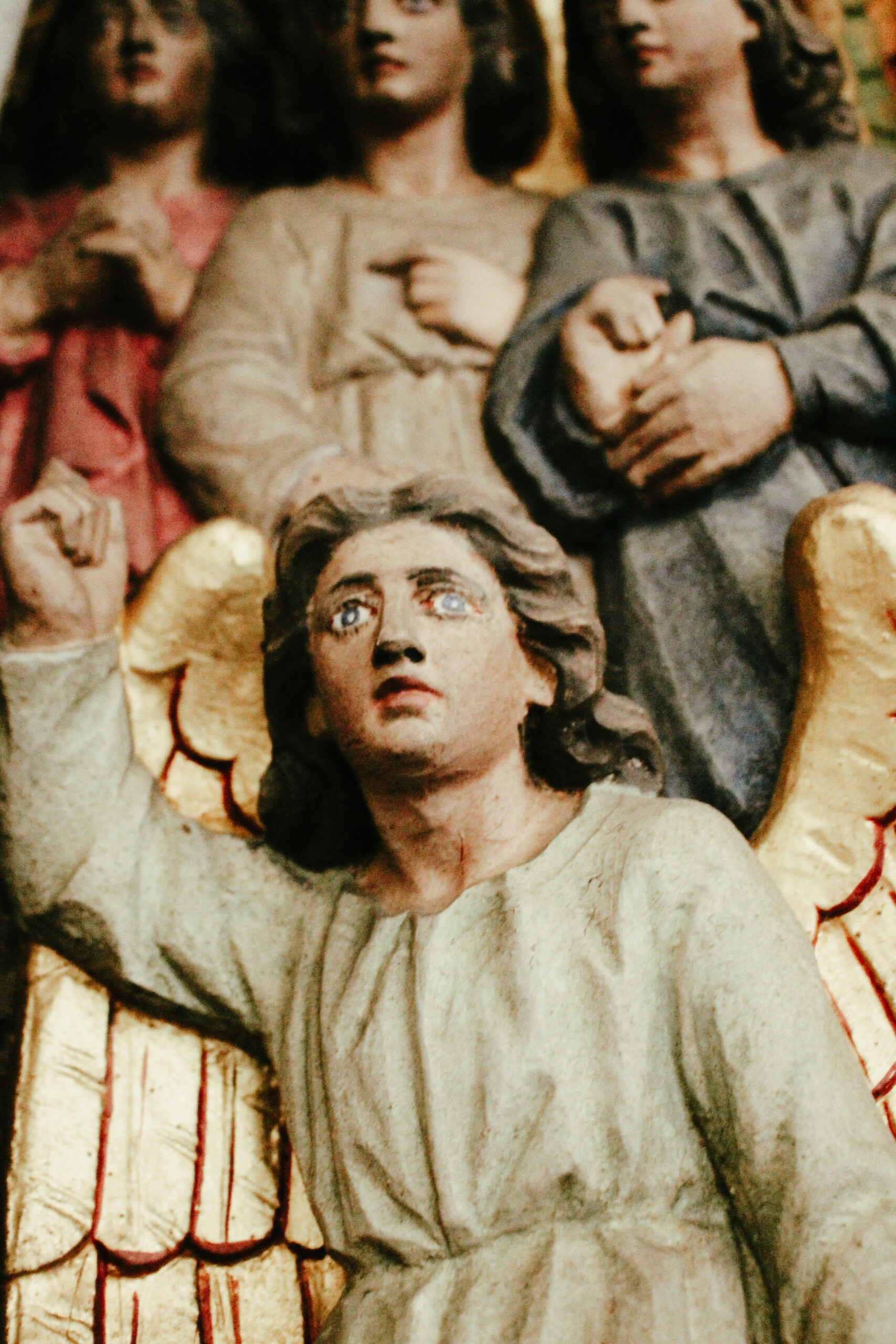
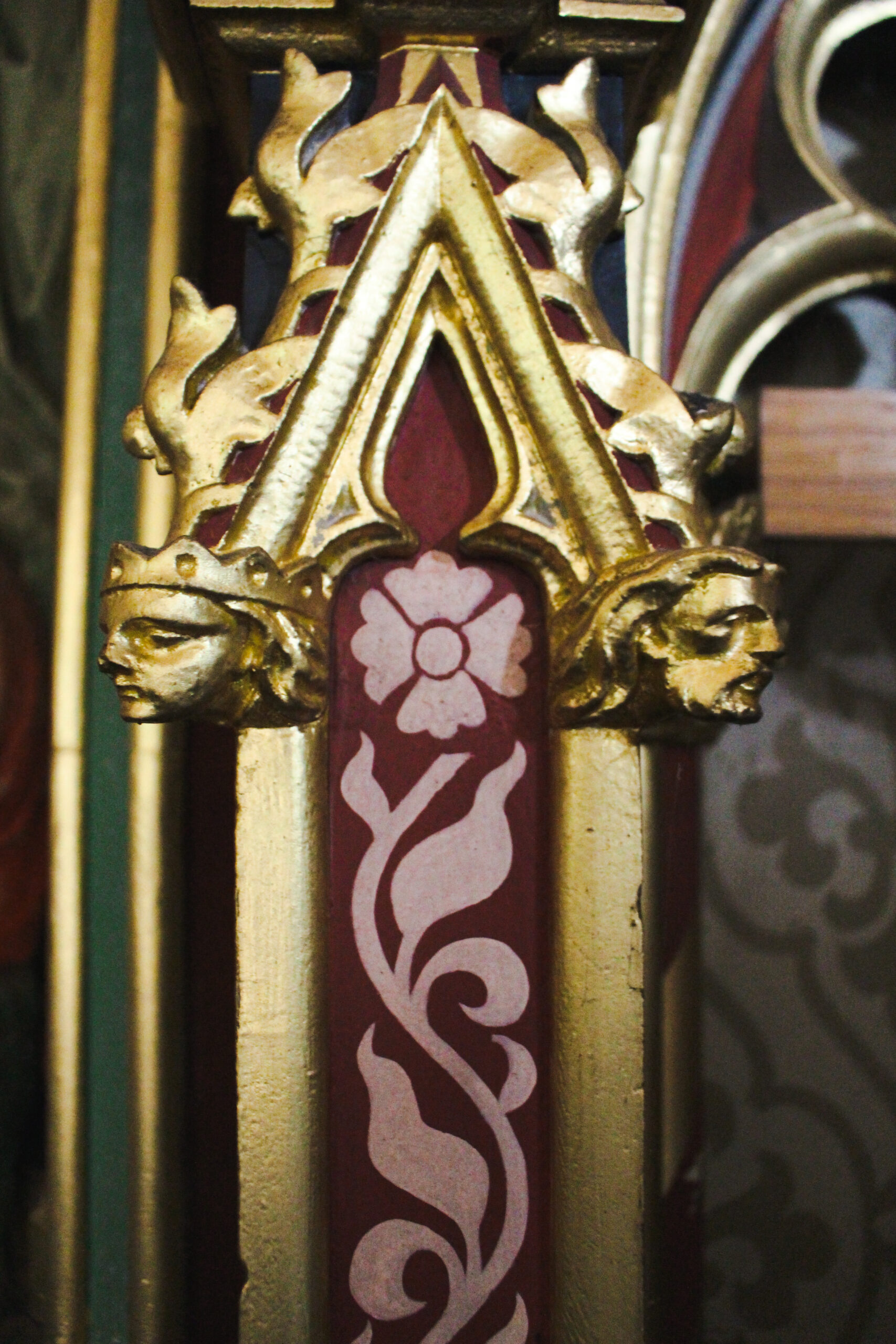


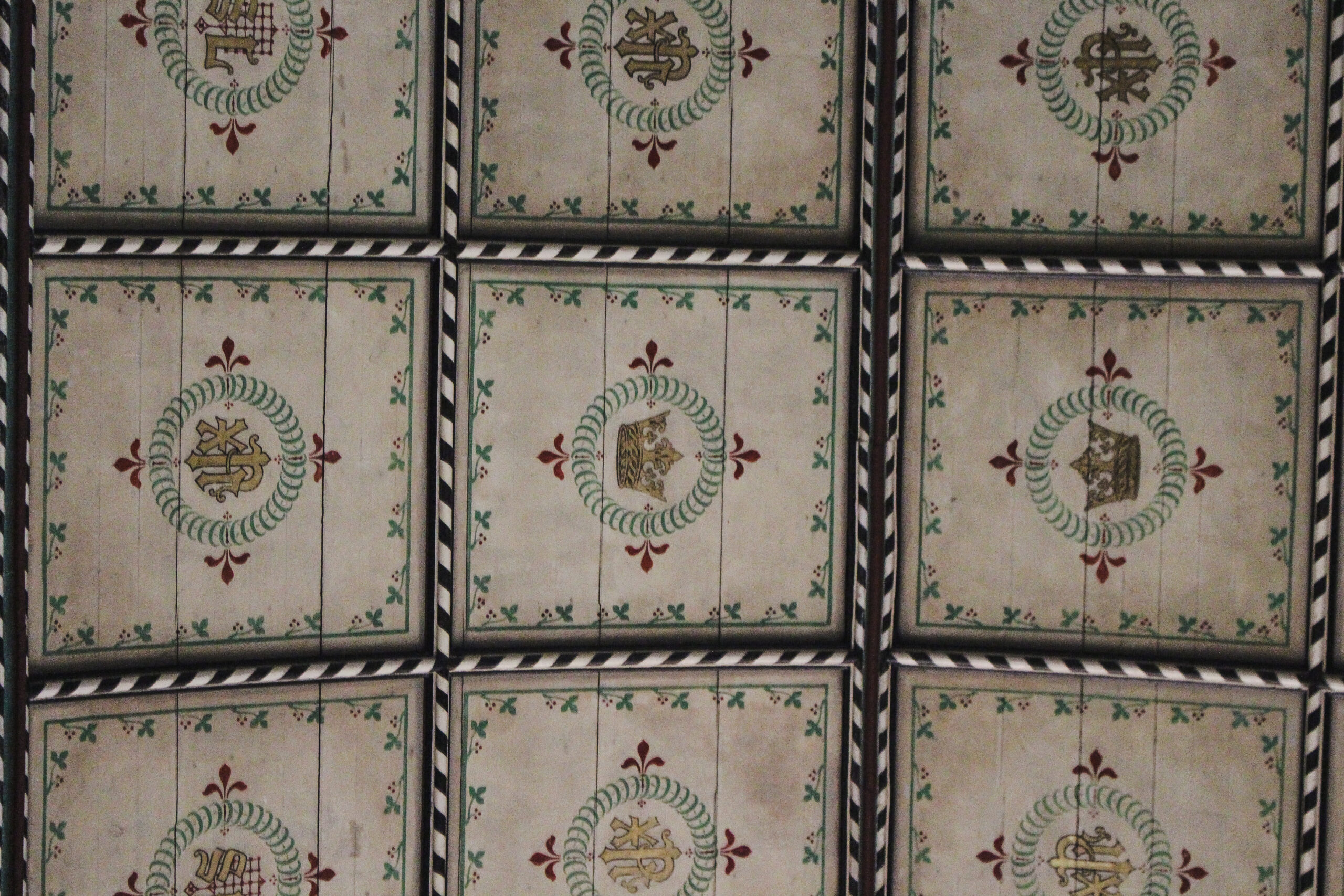
Early 1900s The Chancel Ceiling
The chancel ceiling decoration is believed to have been originally painted in the early 1900s. It has 56 panels, each decorated in gold leaf with one of five symbols. The ceiling was cleaned and repaired in October 2001. The five symbols used are: Alpha and Omega, the first and last letters of the Greek alphabet; the first three letters in Greek of the title Christ; a crown, symbolizing the triumph of the martyrs; the letters SL and a gridiron, representing St Laurence; and the first three letters in Greek of the name Jesus.
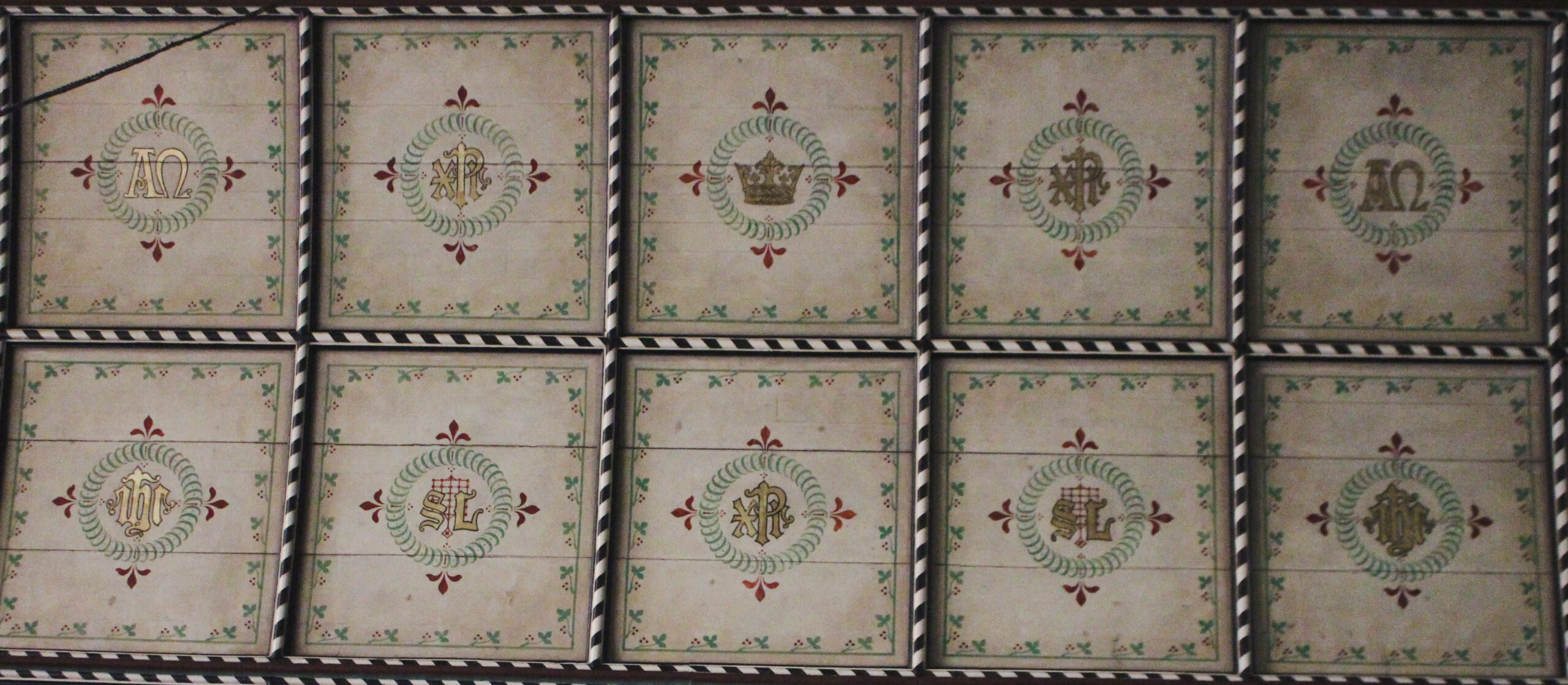
1906 Church Organ
The current church organ is a fine three-manual instrument built and installed by Norman & Beard of Norwich in 1906, to a specification by Dr Charles Harford Lloyd. It replaced the original organ which had been installed by John Avery of Westminster in 1798. It was subject to a major refurbishment in 1996, when it was converted to an electro-pneumatic action, and in April 2016 further repair work was done to the bellows.
For more information about the organ and its predecessor, please click HERE
Our church organist is Christopher Boodle.





1910 The Rood Screen
The Rood Screen and Cross were installed between 1910 and 1914, thanks to the generosity of the local Stanton family. They were created by the Cheltenham architect William Samuel Weatherley, and were donated by the Stanton family in memory of Father Arthur Henry Stanton.




The Stanton Family
The Stanton family have been associated with the church from the 1820s, when William and Ann Stanton of The Thrupp were significant benefactors. The Stanton family were a prominent local family associated with cloth manufacturing and politics: William Henry Stanton, son of William and Ann, was MP for Stroud between 1841 and 1852; and his nephew Walter John Stanton was MP for Stroud briefly in 1874, and from 1880 to 1885.
Arthur Henry Stanton, a grandson of William and Ann, was born at Upfield Lodge in Stroud in 1839. He became curate at St Alban’s in Holborn, London, in 1862, and was to remain there for over 50 years. He was a very popular and respected man, described as an indefatigable champion of the poor, a staunch champion of ritual, and an exuberant preacher, attracting devoted supporters and horrified critics in equal measure. He died back in his native Stroud on 28th March 1913, and his funeral in Holborn was followed by huge crowds. The wooden rood screen between the nave and the choir was donated by the Stanton family in 1912, and the cross above it was added in 1914 in memory of Arthur Henry.
The chancel window and a monument in the west wall of the church are in memory of William and Ann; the window in the Lady Chapel is in memory of Charles Stanton, by his surviving wife Martha; and windows on the north side of the church are dedicated to Alfred John Stanton and his wife Harriet, and Charles Holbrow Stanton, and Walter John Stanton and his wife Mary.

1912 A Fight Over Candlesticks
An extraordinary row erupted in 1912 when vicar Henry Proctor asked for permission to place a pair of candlesticks on a ledge at the back of the altar, with an inscription around the base, “To the glory of God and in memory of the Reverend George Proctor, incumbent of Stroud 1845-1858” – George was Henry’s father. The application was opposed by a Mr Stuart, who claimed “that the placing of candle sticks on, near, or by the altar is unlawful as introducing altar lights and being symbolical, and as being, or leading to, and calculated or intended to lead to an illegal ceremonial use”, and “that the introduction of the candlesticks for lights is contrary to the teaching of the Homilies.” A Consistory Court at Gloucester Cathedral heard the case, which took up many hours over a number of sessions. The following exchange gives a flavour of the proceedings:
The Chancellor: Do you contend that it is illegal to put candles in the candlesticks?
Mr Stuart: Well, I am not prepared to press that to-day.
The Chancellor: You suggest that you cannot light a candle without a ceremony. I think that you can.
Mr Stuart: It has been held that it was illegal to place lighted candles on the Communion table during the celebration of Communion, if they were not wanted for the purpose of giving light, and it has also been held that candlesticks are not ornaments within the meaning of the Rubric. These lights were introduced by Innocent III., and were always used “ceremonially,” which was clearly forbidden by Martin v. MacKonochie in the House of Lords, which distinctly decides that the lighting of candles and the burning them throughout with reference to a service is illegal, and, as admitted by the Archbishop of Canterbury, in his evidence before the Royal Commission, this was not altered by the House of Lords in read v. Bishop of Lincoln.
The Chancellor: It seems to me that if candles are illegal, candlesticks must be illegal too. Candlesticks clearly import candles.
Mr Stuart: Candles are symbolical, and I should submit that if the grant of candlesticks would imply the right to put candles in them and to light them, they are not allowable.
The Chancellor: The whole thing is illegal?
Mr Stuart: Yes, I submit so.
The Chancellor: It is a very serious thing, because in a great many churches there are, at all events, candles.

1900s Life at St Laurence
1912 The Vicarage
There was no permanent residence for the clergy until 1837, when a church house was built on Lansdown. This was demolished in about 1967 to make way for an extension to Stroud Library. In 1912, the then vicar Henry Proctor bought Rodney House (originally built in 1634) next to the church, and this was later bought from him by the diocese for use as the vicarage. The Rodney House vicarage later became the Church Court Care Home, and a new modern vicarage was built nearby to replace it.

1914 World War I
Please click the button below to view 'Lest We Forget', our page to commemorate both World Wars.
1927 The Oak Screen
The oak screen filling the tower arch was designed by the architect Thomas Falconer in partnership with Baker and Campbell, made by Peter van der Waals in the Arts and Crafts style, and dates from 1927. The painting of St George in the tower arch screen is by Edward Raymond Payne of Box, and dates to 1929. Payne was a renowned artist, associated with the Arts & Crafts Movement, who spent most of his working life living in Box, Stroud, where he specialised in stained glass, painting, and teaching.


1931 Service or Sensation in Religion
“On a spot hallowed by upwards of 700 years of public worship, I joined a congregation of some two or three hundred, for a service on Sunday morning …. Quiet dignity, typical it seemed of the Church itself, marked Sunday morning’s service. There was, however, every indication that the Church was keeping abreast of the times, and that it is progressive. When it is remembered that the Rev. G. F. Helm, the popular ex-padre of the 1/5th Gloucesters, is the Vicar, this state of affairs is expected …. When I took my seat in the church the bell was sonorously tolling the people to service. Hardly had its last note died away when the organist began to play, the soft, melodious music coming in great contrast to the previous sounds. The procession of the surpliced choir and clergy up the aisle and into the choir stalls was very stately, and added dignity was given by the white head dress of the lady choristers. I expected to hear some good singing, noting the strength of the choir, and I was not disappointed. During the course of the service I was rather surprised at the way most of the congregation relied on the choir for the singing and responses. The mere fact that the choir did it well was really no excuse, I venture to suggest, for some members of the congregation remained dumb. However, the choir sang really very pleasingly, and I detected that great care had been paid in the preparation of the musical side of the service. When I remembered that Mr. S. W. Underwood was the organist and choirmaster, and knowing his power to develop natural talents in others, I looked for no other explanation for the choir’s excellent performance. To return to the service itself, two things, apart from the sermon, rather struck me. They were the way the curate – the Rev. A. J. G. Chard – took the service, and the way Major Craik read the lessons. Mr. Chard possesses a musical voice, and this was particularly evidenced when he led the recital of the Litany …. Major Craik read the lessons in the way they ought to be read – with perfect enunciation, so clearly in fact that everybody could hear. The sermon was delivered by the Vicar, and was characteristic of him. Fearless, and, when occasion demands it, outspoken, he pressed home one or two truths in a convincing way …. I found it very refreshing to listen to Mr. Helm once again. I learned that since he left Gloucester to go to Stroud he has done fine work. One would expect a man who did so much to lighten the way for a local battalion in France, - to wit, the 1/5th Glosters – among whom were many Stroud men, to give a fine manly lead to a parish, and this is finding its response in Stroud.”
A special report by “Wandering Worshipper” in the Gloucester Journal, 28 February 1931


1931 The Sanctuary Lamp
The dedication reads: “The Sanctuary Lamp in this Chapel was given in memory of his mother Catherine Emma, by George Francis Helm, Vicar of this Parish and dedicated by him on the Sunday after Ascension Day [14 May] 1931”. Catherine had died in 1929.

The Parish Magazine





1958 New Altar Frontal and Cloth
The 1958 Stroud Festival performance at St Laurence was tinged with some sadness at the passing away of Samuel Underwood earlier that year. It also saw the dedication of a new altar frontal and cloth. In front of a crowded congregation, Marjorie Cox addressed the vicar, Arthur Maltin: “Reverend Sir, will you please accept this Altar frontal and Fair Linen cloth, designed and embroidered by senior girls of the Stroud Technical School, on cloth made at and presented by a local cloth mill, and ask the Lord Bishop [of Gloucester – Dr WM Askwith] to dedicate them to “the Glory of God” and in memory of our late headmistress, Miss Heather Trout, who with the School was closely associated with the Stroud Religious Drama Festival.” Due to television coverage, the new altar frontal attracted much attention and it was later displayed at the Three Choirs Festival, and exhibited at an exhibition of contemporary church embroidery in East Grinstead, Surrey.


1960s
Stan Wyatt's photographs of the church and The Shambles for Stroud Festival, 1960
Revd Cooper's Guide to St Laurence Church, about 1960
St Laurence Church from Bank Gardens, about 1960 and
St Laurence Men's Society, early 1960s
From left to right: Peter Young; Revd Clive Copper, Vicar of St Laurence; ?; ?; ?; Revd Gordon White, Curate; David Hengist; ?; Mr Jeffreys, Lay Reader; Stanley Wyatt
1965 Fish and Chips
In May 1965, worshippers at St Laurence were confronted with a notice asking visitors to "refrain from eating fish and chips", put up by the new vicar John Edwin Tillett. He was concerned about the growing problem of people using the church as a venue for eating their lunch and then leaving litter behind. He said the church porch was left with a bad smell and that chicken bones and fish and chip papers were left in the Easter garden.
The photo shows The Shambles in 1965, where a local market has been held almost continuously since at least the 16th century. On the east side is the old market house dating to about 1590, which has also been used in its time as a school, and, up to 1989, as local council offices. On the west side is the church hall, originally The Butchers Arms public house, and then the Corn Hall. The last remaining hinged butcher’s table is fixed to the wall under the 19th century arcade.

1967 Divine Inspiration
According to the Western Daily Press, a team of water diviners equipped with hazel dowsing twigs, plotted the course of underground streams in June 1967 in a bid to save the foundations of the church. The site on which the church sits is affected by a large area fed by underground springs. The vicar, Revd John Tillett, was quoted at the time as saying, “I neither believe nor disbelieve in water divining. As long as they can find the source of the trouble I don’t care how it is done.”

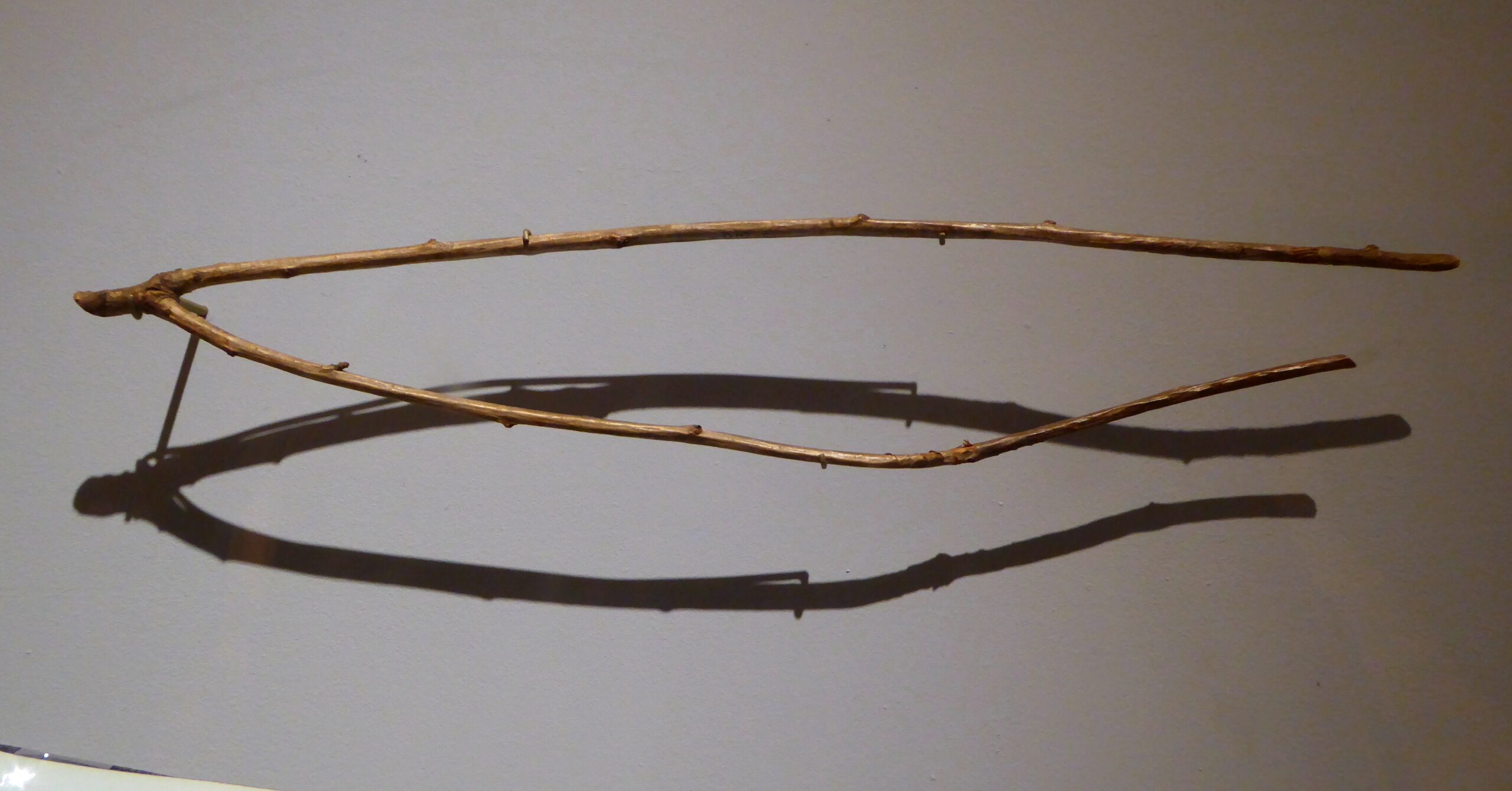
This photo shows Revd John Tillett (seen on the right), presiding at a marriage at St Laurence in 1968 with two other ministers: Revd John Lewis, then Vicar of Cirencester, later Archdeacon of Cheltenham (centre) and Revd Frederick Clark (left).
Frederick was the Navigator of a Lancaster which was shot down over Germany in 1943. Despite injuring his ankle while landing in his parachute, he was on the run for a week before being captured and sent to a prisoner of war camp, which he thankfully survived. Some years later he was ordained and served for many years as a non-stipendiary (unpaid) assistant to several Vicars of St Laurence. He was awarded an MBE in 1968.
1967 Divine Inspiration
According to the Western Daily Press, a team of water diviners equipped with hazel dowsing twigs, plotted the course of underground streams in June 1967 in a bid to save the foundations of the church. The site on which the church sits is affected by a large area fed by underground springs. The vicar, Revd John Tillett, was quoted at the time as saying, “I neither believe nor disbelieve in water divining. As long as they can find the source of the trouble I don’t care how it is done.”


This photo shows Revd John Tillett (seen on the right), presiding at a marriage at St Laurence in 1968 with two other ministers: Revd John Lewis, then Vicar of Cirencester, later Archdeacon of Cheltenham (centre) and Revd Frederick Clark (left).
Frederick was the Navigator of a Lancaster which was shot down over Germany in 1943. Despite injuring his ankle while landing in his parachute, he was on the run for a week before being captured and sent to a prisoner of war camp, which he thankfully survived. Some years later he was ordained and served for many years as a non-stipendiary (unpaid) assistant to several Vicars of St Laurence. He was awarded an MBE in 1968.











































